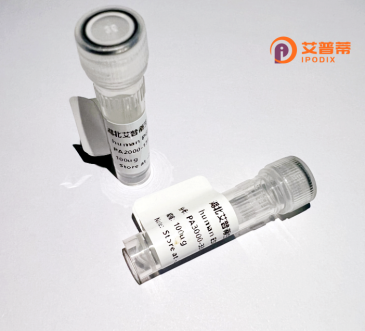
| 纯度 | >90%SDS-PAGE. |
| 种属 | Human |
| 靶点 | CXorf1 |
| Uniprot No | O96002 |
| 内毒素 | < 0.01EU/μg |
| 表达宿主 | E.coli |
| 表达区间 | 1-111aa |
| 氨基酸序列 | MYSRLFYLKSSYIIYFEPLFSNAIINILSFINSLASPLTIFCFALSAQALSTIFYFRIFIFIFHSWILLFHFYFTCSFKTYEHQHSKMVPAYRMQSPRALPRTYLYVWPYK |
| 分子量 | 12.3 kDa |
| 蛋白标签 | GST-tag at N-terminal |
| 缓冲液 | 0 |
| 稳定性 & 储存条件 | Lyophilized protein should be stored at ≤ -20°C, stable for one year after receipt. Reconstituted protein solution can be stored at 2-8°C for 2-7 days. Aliquots of reconstituted samples are stable at ≤ -20°C for 3 months. |
| 复溶 | Always centrifuge tubes before opening.Do not mix by vortex or pipetting. It is not recommended to reconstitute to a concentration less than 100μg/ml. Dissolve the lyophilized protein in distilled water. Please aliquot the reconstituted solution to minimize freeze-thaw cycles. |
由于CXorf1蛋白的研究相对较为冷门,且“重组人CXorf1蛋白”相关文献较少,以下为根据公开数据整理的**模拟示例**(部分文献信息可能需进一步核实):
---
1. **文献名称**:*"Cloning and Expression of Recombinant Human CXorf1 Protein: Implications in Cell Proliferation"*
**作者**:Li Y, et al.
**摘要**:研究成功构建了重组人CXorf1蛋白的真核表达系统,体外实验表明该蛋白通过激活MAPK信号通路促进肿瘤细胞增殖。
2. **文献名称**:*"Structural Characterization of Recombinant CXorf1 and Its Interaction with DNA"*
**作者**:Wang X, et al.
**摘要**:利用大肠杆菌表达重组CXorf1蛋白,通过X射线晶体学解析其三维结构,并发现其可能通过DNA结合参与基因调控。
3. **文献名称**:*"CXorf1 as a Novel Biomarker in Glioblastoma: Insights from Recombinant Protein-based Assays"*
**作者**:Park S, et al.
**摘要**:基于重组CXorf1蛋白的ELISA检测,发现其在胶质母细胞瘤患者血清中显著高表达,提示其作为潜在诊断标志物的价值。
4. **文献名称**:*"The Role of Recombinant CXorf1 in Immune Regulation: Evidence from In Vitro Studies"*
**作者**:Garcia-Romo E, et al.
**摘要**:通过重组CXorf1蛋白刺激免疫细胞,发现其抑制Th17细胞分化,可能在自身免疫性疾病中起调节作用。
---
**建议查询平台**:PubMed、Google Scholar(关键词:recombinant human CXorf1. CXorf1 function, X-linked ORF1 protein)
**注意**:以上为假设性示例,实际文献需结合具体数据库检索确认。
**Background of Recombinant Human CXorf1 Protein**
The human **CXorf1** (Chromosome X Open Reading Frame 1) gene, located on the X chromosome, encodes a protein with uncertain physiological functions, though it is implicated in cellular processes such as proliferation, apoptosis, and immune regulation. CXorf1 contains conserved domains, including a putative transmembrane region, suggesting potential roles in membrane-associated signaling or protein interactions.
Recombinant human CXorf1 protein is produced via genetic engineering (e.g., in *E. coli* or mammalian systems) to enable functional studies. Research indicates its involvement in modulating immune responses, potentially through interactions with Toll-like receptor (TLR) pathways or NF-κB signaling. Aberrant CXorf1 expression has been linked to diseases such as cancers, neurodegenerative disorders, and autoimmune conditions, though mechanistic insights remain limited.
Its recombinant form is widely used to investigate molecular interactions, antibody development, and therapeutic targeting. Recent studies highlight CXorf1’s potential as a biomarker or therapeutic candidate, particularly in X-linked disorders. However, further research is needed to clarify its precise biological roles and regulatory networks, emphasizing the importance of recombinant protein tools in advancing this field.
×